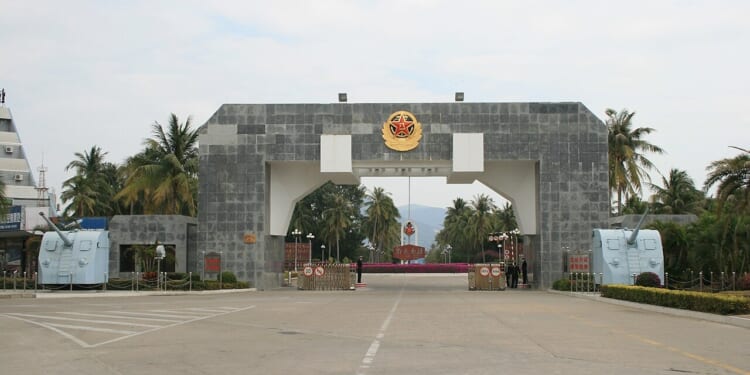The Type 003 Fujian, commissioned into the People’s Liberation Army Navy earlier in November, will be stationed at China’s Yulin Naval Base in southern Hainan—overlooking the South China Sea.
Despite a 2016 international tribunal ruling against China’s claim to the near-entirety of the South China Sea, the Chinese Communist Party (CCP) has made it clear that it views nearly all of the sea as its own sovereign territory. This has predictably resulted in tensions with China’s neighbors, and has even led to clashes between the Chinese Coast Guard and neighboring navies—particularly the Philippine Navy.
A game of brinksmanship has continued as China’s rivals have responded to Beijing. The Philippines has upgraded its military capabilities and fortified island outposts with anti-ship missiles. At the same time, Vietnam has continued to increase its presence in the South China Sea by transforming numerous small, previously uninhabited islands with new fortifications, buildings, and other facilities to support its claims to the waters.
Hanoi’s efforts have not yet reached the scale of the military bases that China has built on its artificial islands, but the island buildup continues. Vietnam has nearly 70 percent as much reclaimed land in the Spratly Island chain as China has—and it could surpass Beijing’s presence in short order if current trends persist.
China Has Multiple Aircraft Carriers in the South China Sea
Beijing will have a critical advantage over the Philippines and Vietnam: it has a brand-new aircraft carrier, and its various regional adversaries do not.
The People’s Liberation Army Navy (PLAN) now has three aircraft carriers, but it is the Type 003 Fujian (18) that could be a game changer. This second domestically-produced flattop, which was commissioned into service last week, is far more advanced than the preceding Type 001 Liaoning and Type 002 Shandong. The new carrier is equipped with a flat flight deck as well as electromagnetic catapults, which can both increase the number of sorties that can be launched from the carrier and the size (and loadout) of the planes involved. This technology can also allow for heavier fixed-wing manned aircraft and unmanned aerial systems (UAS) to operate from the warship.
More importantly, the Fujian will be based at Yulin Naval Base near Sanya in Hainan province, located just north of the South China Sea. The Yulin Naval Base is the primary PLAN facility in the region. Construction on the main base began in 2000 and continued until 2010, when it was subsequently expanded. In 2021, the base was again upgraded to accommodate nuclear submarines.
Last year, an aircraft carrier pier, just under a half-mile in length, was completed at the Yulin Naval Base. The addition of the pier will enable both the Type 002 Shandong and the Type 003 Fujian to operate from Yulin Naval Base, and maintain a regular presence close to the contested South China Sea. The PLAN’s oldest carrier, the Type 001 Liaoning, will remain homeported at the Yuchi Naval Base near Qingdao in China’s northern Shandong province, bordering the Yellow Sea.
“Taking into account factors such as combat readiness needs, port conditions, support capabilities, and mission characteristics, the ship’s permanent base is the Sanya naval port,” Senior Captain Leng Guowei, PLAN spokesperson, told Newsweek.
Leng added, “China’s development and improvement of weaponry are not directed against any country or specific target, and will not pose a threat to any country or region; they are solely for safeguarding national sovereignty, security and development interests.”
Is a Carrier Showdown Looming with the United States?
The United States Navy has regularly deployed carriers to the South China Sea, much to the ire of Beijing, which has had to accept this for decades. China will now be able to deploy multiple carriers to the region simultaneously, a capability that the US Navy can also achieve, albeit for shorter periods.
Only one US Navy carrier, the Nimitz-class USS George Washington (CVN-73), is regularly deployed in the Indo-Pacific, homeported at the Yokosuka Naval Base in Japan. The rest of the US Navy’s flattops are based either on the West Coast or the East Coast of the United States. Although carriers are routinely deployed to the Indo-Pacific, it can take many days for a West Coast flattop to reach the region, and weeks for East Coast-based carriers.
In addition to CVN-73, the US Navy does have the America-class amphibious assault ship USS Tripoli (LHA-7) forward deployed to Sasebo, Japan. Although it is significantly smaller than even the Type 002 Shandong, LHA-7 is able to carry the fifth-generation Lockheed Martin F-35B Lightning II, the short takeoff and vertical landing (STOVL) variant of the Joint Strike Fighter.
More flattops could be sailing the waters of the South China Sea, and the waters could soon feel almost crowded as a result.
About the Author: Peter Suciu
Peter Suciu has contributed over 3,200 published pieces to more than four dozen magazines and websites over a 30-year career in journalism. He regularly writes about military hardware, firearms history, cybersecurity, politics, and international affairs. Peter is also a contributing writer for Forbes and Clearance Jobs. He is based in Michigan. You can follow him on Twitter: @PeterSuciu. You can email the author: [email protected].
Image: Wikimedia Commons.
















